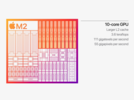Apple M4 Max 32-Core GPU vs Apple M2 8-Core GPU
Apple M4 Max 32-Core GPU
► remove from comparison
The Apple M4 Max GPU (32 cores) is an integrated graphics adapter that's built into the 14-core Apple M4 Max SoC. It features 32 "cores" and has access to at least 36 GB of fast 410 GB/s LPDDR5x on-package RAM depending on the configuration. As is typical for graphics adapters released in 2024, it has hardware support for ray tracing as well as mesh shading and other modern technologies. It also supports external displays with resolutions as high as "8K" and can HW-decode a few popular video codecs such as h.264, h.265 and AV1.
Performance
Its gaming performance is set to be approximately as good as that of the GeForce RTX 4060 Laptop. Please keep in mind that very few games have been compiled specifically for Apple silicon Macs meaning most titles have to be run via emulation layers. Some of them are displayed with visual artefacts as a result, or don't start at all.
Power consumption
Given the power on offer, we expect the iGPU to consume over 40 W when under heavy loads.
Just like the rest of the Apple M4 Max chip, the integrated graphics adapter is manufactured on a "second generation 3 nm" TSMC process which is still cutting-edge as of late 2024.
Apple M2 8-Core GPU
► remove from comparison
The Apple M2 8-core GPU is an integrated graphics card offering 8 of the 10 cores designed by Apple and integrated in the Apple M2 SoC. It uses the unified memory architecture of the M2 SoC (up to 24 GB LPDDR5-6400 with 100 GB/s bandwidth) and should offer 128 execution units.
The performance is positioned right between the old 8-core model in the M1 GPU and the higher end 10-core model in the M2. The theoretical performance should be around 2.9 Teraflops, as the 8-core version offers the same 1,398 MHz maximum clock rate as the 10-core version. Compared to other iGPUs from AMD and Intel, the M2 benefits greatly from the unified memory architecture and the high bandwidth.
The M2 chip is manufactured in the second generation 5nm process at TSMC (most likely N5P). The power consumption is around 10 Watt (in our tests under load of the MBP13) compared to the 13.5W of the 10-core version.
| Apple M4 Max 32-Core GPU | Apple M2 8-Core GPU | |||||||||||||||||||||||||||||||||||||
| Apple M2 Series |
|
| ||||||||||||||||||||||||||||||||||||
| Pipelines | 32 - unified | 8 - unified | ||||||||||||||||||||||||||||||||||||
| Raytracing Cores | 32 | |||||||||||||||||||||||||||||||||||||
| Memory Speed | 8533 MHz | |||||||||||||||||||||||||||||||||||||
| Memory Type | LPDDR5x-8533 | LPDDR5-6400 | ||||||||||||||||||||||||||||||||||||
| Shared Memory | yes | no | ||||||||||||||||||||||||||||||||||||
| Memory Bandwidth | 410 GB/s | |||||||||||||||||||||||||||||||||||||
| Power Consumption | 45 Watt | 10 Watt | ||||||||||||||||||||||||||||||||||||
| technology | 3 nm | 5 nm | ||||||||||||||||||||||||||||||||||||
| Displays | 3 Displays (max.) | |||||||||||||||||||||||||||||||||||||
| Notebook Size | large | |||||||||||||||||||||||||||||||||||||
| Date of Announcement | 30.10.2024 | 06.06.2022 | ||||||||||||||||||||||||||||||||||||
| Predecessor | M3 Max 30-Core GPU | M1 8-Core GPU | ||||||||||||||||||||||||||||||||||||
| Core Speed | 1398 (Boost) MHz |
| |||||||||
Benchmarks
Cinebench R15 OpenGL 64 Bit + Apple M2 8-Core GPU
GFXBench T-Rex HD Offscreen C24Z16 + Apple M2 8-Core GPU
Average Benchmarks Apple M4 Max 32-Core GPU → 0% n=0
Average Benchmarks Apple M2 8-Core GPU → 0% n=0
* Smaller numbers mean a higher performance
1 This benchmark is not used for the average calculation
Game Benchmarks
The following benchmarks stem from our benchmarks of review laptops. The performance depends on the used graphics memory, clock rate, processor, system settings, drivers, and operating systems. So the results don't have to be representative for all laptops with this GPU. For detailed information on the benchmark results, click on the fps number.

Borderlands 3
2019| Apple M4 Max 32-Core GPU | Apple M2 8-Core GPU | |||||||||||||
|---|---|---|---|---|---|---|---|---|---|---|---|---|---|---|
| low | med. | high | ultra | QHD | 4K | low | med. | high | ultra | QHD | 4K | |||
| Borderlands 3 | 43 | 29.7 | 16.6 | 13.4 | ||||||||||
| Total War: Three Kingdoms | 77 | 39 | 18 | 14 | ||||||||||
| Shadow of the Tomb Raider | 62 | 28 | 24 | 20 | ||||||||||
| Apple M4 Max 32-Core GPU | Apple M2 8-Core GPU | |||||||||||||
| low | med. | high | ultra | QHD | 4K | low | med. | high | ultra | QHD | 4K | < 30 fps < 60 fps < 120 fps ≥ 120 fps | | | | | | | < 30 fps < 60 fps < 120 fps ≥ 120 fps | 1 2 | 2 1 | 3 | 3 | | |
For more games that might be playable and a list of all games and graphics cards visit our Gaming List














